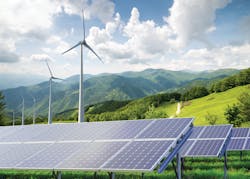The power of integrated automation and electrical systems
When first charged with this responsibility, Jabulani faced process automation and monitoring systems that were never designed to quantify or optimize operations against carbon emissions. A range of independent reports were available through various dashboards and reporting systems, but for the most part emissions were calculated only in retrospect based on a series of assumptions and approximations.
“You can’t control what you don’t measure,” Jabulani explains. “So, at first it was a lot of basic blocking and tackling, adding a range of process analyzers and sensors necessary to gather the information we needed to get a handle on sustainable effects in real time.”
And where direct sustainability measurements were infeasible, Jabulani was able to leverage the capabilities of the latest generation of ABB process automation systems that had recently been implemented. “Our ABB process automation system now includes an embedded digital twin of the process that we can use to not only model emissions in real time but also test the impact of proposed changes,” Jabulani says.
“We can also leverage the system’s two-tiered segregation between a control core, where critical loops and logic are executed, together with a secondary application ecosystem where we can readily download and install complementary Industrial IoT applications designed specifically to calculate, manage and report on carbon emissions and other sustainability effects.”
A new normal
“Today, it’s easy to know the real-time sustainability status of our operations,” Jabulani says. “We know our carbon footprint, plus just how much waste we’re producing and how much water we’re consuming, among other KPIs.” Furthermore, the mill’s process automation system helps to adjust operations to reach sustainability targets, such as by curtailing the operation of non-critical equipment during the daytime hours when electricity is most expensive, by planning maintenance activities to ensure runtime of critical assets to not create waste, and by suggesting alternate production schedules to meet KPI targets.
“Because of our success on these initiatives, our plant was chosen by corporate as the proving ground for next-generation process innovations that are fundamentally transforming the environmental friendliness of aluminum production,” Jabulani says. This includes breaking ground on inhouse photovoltaic and wind turbine systems on adjacent property, as well as a series of electrolytic systems to convert that renewable energy into green hydrogen that can effectively replace the fossil fuels used to power the plant’s refining and smelting processes.
“ABB’s longstanding expertise in the control of electrical systems—and their meaningful coordination with process systems—means that we can readily integrate, control and optimize the operations of our entire production operation with eye toward sustainability objectives,” Jabulani says.
Longer term, he envisions that the plant’s increasingly autonomous process automation and electrical control systems will allow people to develop their creative capacities and higher-level problem-solving skills more fully, while robots handle repetitive tasks without human intervention and drones keep people at a safe distance from hazardous operations. “Smart technologies including artificial intelligence, machine learning, the Industrial IoT and digital twins will help reduce and reverse greenhouse gas emissions, enable resilient operations and improve people’s lives.”
Note: The characters and organizations depicted in this vision are fictitious. The ABB DCS Vision, however, is very real. Download the white paper at https://new.abb.com/control-systems/control-systems/envisioning-the-future-of-process-automation-systems.
This was just one stop on our tour of ABB's Process Automation Systems Vision 10 years in the future. Don't miss a single stop. Read more at the articles below.
About the Author
ABB
ABB

Leaders relevant to this article:

